BM533 Microeconomic Analysis: Demand, Supply, and Economic Theories
VerifiedAdded on 2022/08/27
|14
|3730
|15
Report
AI Summary
This report provides a comprehensive analysis of microeconomic theory, focusing on the concepts of demand and supply within the context of Tesco, a major retail business. Task 1 delves into the law of demand and supply, examining movements along the curves and shifts in the curves due to various factors such as price fluctuations, seasonal changes, income levels, and production costs, supported by relevant diagrams. The analysis considers the oligopoly market structure in which Tesco operates. Task 2 compares and contrasts economic theories and models of the 20th and 21st centuries, evaluating their application in modern business practices. The report covers significant economic events, including the Great Depression and the evolution of economic thought. The document is well-structured, providing a clear introduction, detailed discussions, and a concluding summary of the key findings, supported by appropriate references.
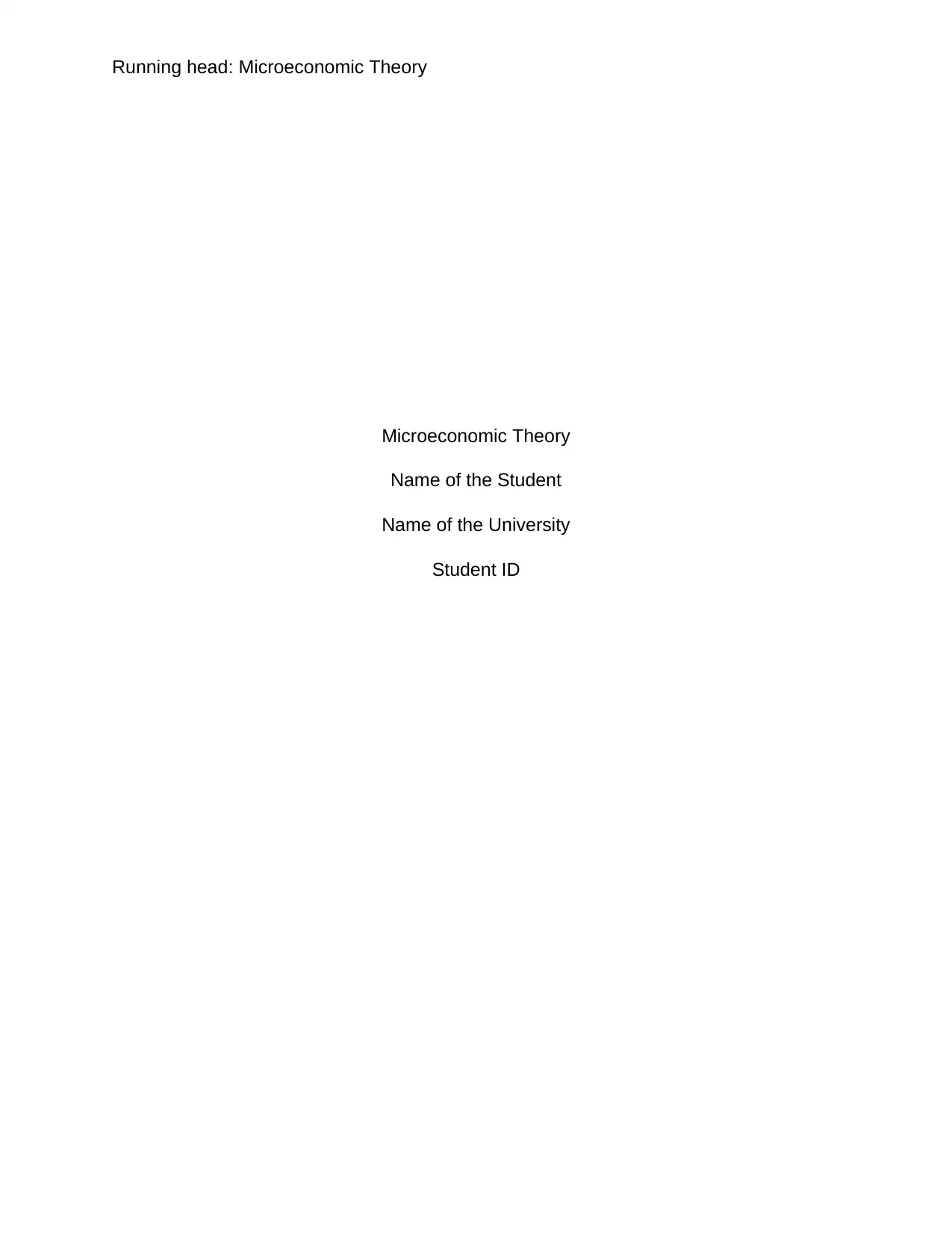
Running head: Microeconomic Theory
Microeconomic Theory
Name of the Student
Name of the University
Student ID
Microeconomic Theory
Name of the Student
Name of the University
Student ID
Paraphrase This Document
Need a fresh take? Get an instant paraphrase of this document with our AI Paraphraser
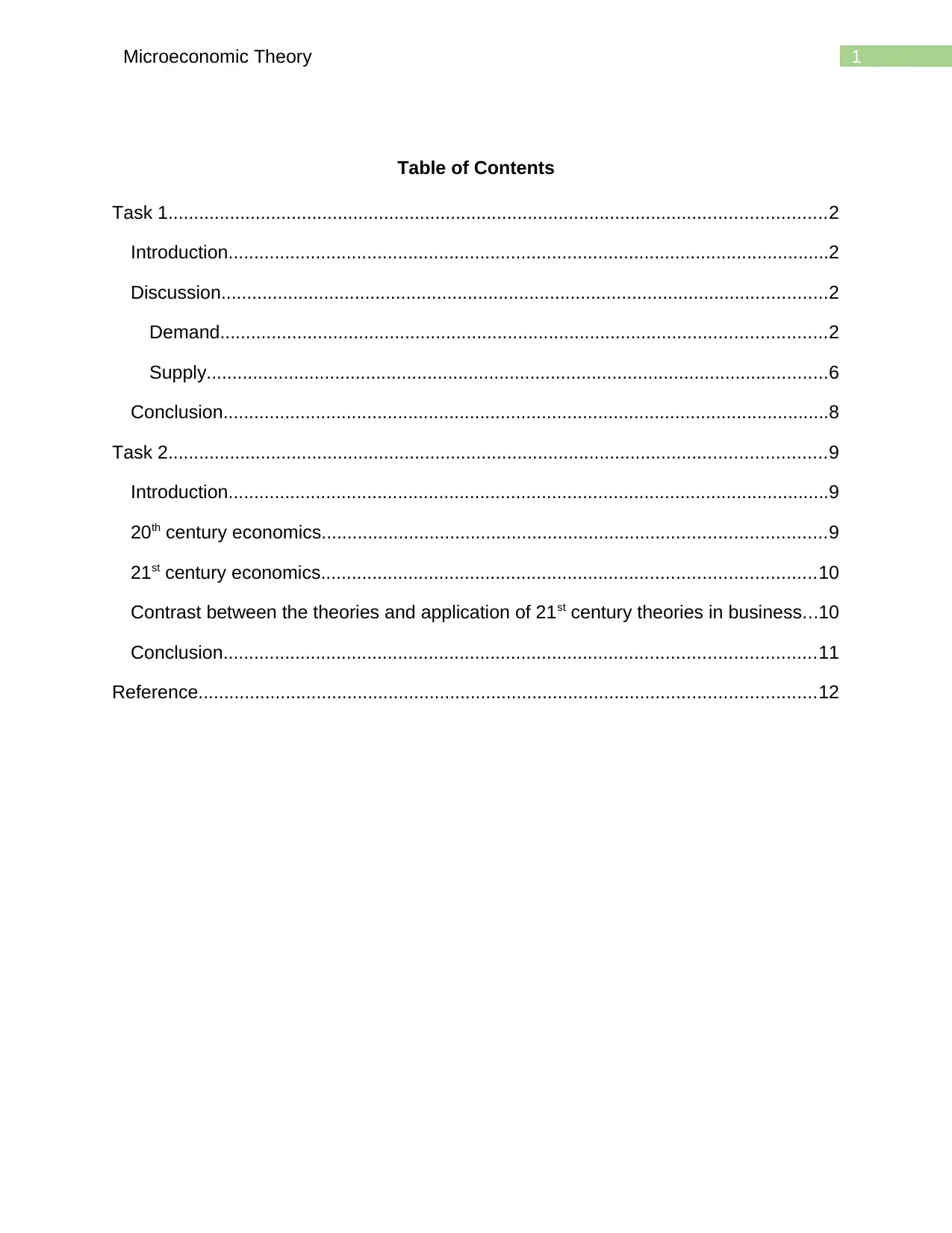
1Microeconomic Theory
Table of Contents
Task 1................................................................................................................................2
Introduction.....................................................................................................................2
Discussion......................................................................................................................2
Demand......................................................................................................................2
Supply.........................................................................................................................6
Conclusion......................................................................................................................8
Task 2................................................................................................................................9
Introduction.....................................................................................................................9
20th century economics..................................................................................................9
21st century economics................................................................................................10
Contrast between the theories and application of 21st century theories in business...10
Conclusion...................................................................................................................11
Reference........................................................................................................................12
Table of Contents
Task 1................................................................................................................................2
Introduction.....................................................................................................................2
Discussion......................................................................................................................2
Demand......................................................................................................................2
Supply.........................................................................................................................6
Conclusion......................................................................................................................8
Task 2................................................................................................................................9
Introduction.....................................................................................................................9
20th century economics..................................................................................................9
21st century economics................................................................................................10
Contrast between the theories and application of 21st century theories in business...10
Conclusion...................................................................................................................11
Reference........................................................................................................................12
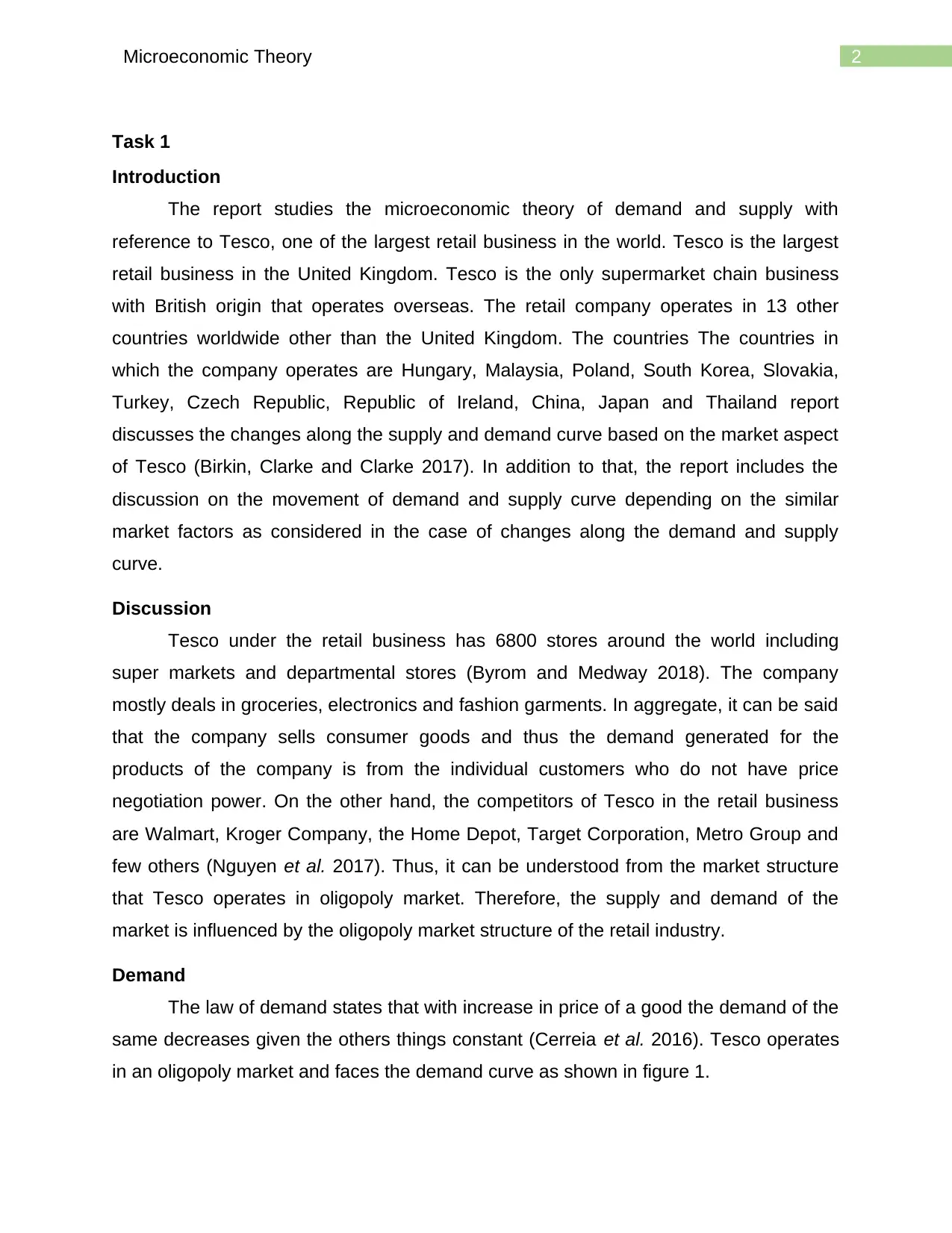
2Microeconomic Theory
Task 1
Introduction
The report studies the microeconomic theory of demand and supply with
reference to Tesco, one of the largest retail business in the world. Tesco is the largest
retail business in the United Kingdom. Tesco is the only supermarket chain business
with British origin that operates overseas. The retail company operates in 13 other
countries worldwide other than the United Kingdom. The countries The countries in
which the company operates are Hungary, Malaysia, Poland, South Korea, Slovakia,
Turkey, Czech Republic, Republic of Ireland, China, Japan and Thailand report
discusses the changes along the supply and demand curve based on the market aspect
of Tesco (Birkin, Clarke and Clarke 2017). In addition to that, the report includes the
discussion on the movement of demand and supply curve depending on the similar
market factors as considered in the case of changes along the demand and supply
curve.
Discussion
Tesco under the retail business has 6800 stores around the world including
super markets and departmental stores (Byrom and Medway 2018). The company
mostly deals in groceries, electronics and fashion garments. In aggregate, it can be said
that the company sells consumer goods and thus the demand generated for the
products of the company is from the individual customers who do not have price
negotiation power. On the other hand, the competitors of Tesco in the retail business
are Walmart, Kroger Company, the Home Depot, Target Corporation, Metro Group and
few others (Nguyen et al. 2017). Thus, it can be understood from the market structure
that Tesco operates in oligopoly market. Therefore, the supply and demand of the
market is influenced by the oligopoly market structure of the retail industry.
Demand
The law of demand states that with increase in price of a good the demand of the
same decreases given the others things constant (Cerreia et al. 2016). Tesco operates
in an oligopoly market and faces the demand curve as shown in figure 1.
Task 1
Introduction
The report studies the microeconomic theory of demand and supply with
reference to Tesco, one of the largest retail business in the world. Tesco is the largest
retail business in the United Kingdom. Tesco is the only supermarket chain business
with British origin that operates overseas. The retail company operates in 13 other
countries worldwide other than the United Kingdom. The countries The countries in
which the company operates are Hungary, Malaysia, Poland, South Korea, Slovakia,
Turkey, Czech Republic, Republic of Ireland, China, Japan and Thailand report
discusses the changes along the supply and demand curve based on the market aspect
of Tesco (Birkin, Clarke and Clarke 2017). In addition to that, the report includes the
discussion on the movement of demand and supply curve depending on the similar
market factors as considered in the case of changes along the demand and supply
curve.
Discussion
Tesco under the retail business has 6800 stores around the world including
super markets and departmental stores (Byrom and Medway 2018). The company
mostly deals in groceries, electronics and fashion garments. In aggregate, it can be said
that the company sells consumer goods and thus the demand generated for the
products of the company is from the individual customers who do not have price
negotiation power. On the other hand, the competitors of Tesco in the retail business
are Walmart, Kroger Company, the Home Depot, Target Corporation, Metro Group and
few others (Nguyen et al. 2017). Thus, it can be understood from the market structure
that Tesco operates in oligopoly market. Therefore, the supply and demand of the
market is influenced by the oligopoly market structure of the retail industry.
Demand
The law of demand states that with increase in price of a good the demand of the
same decreases given the others things constant (Cerreia et al. 2016). Tesco operates
in an oligopoly market and faces the demand curve as shown in figure 1.
⊘ This is a preview!⊘
Do you want full access?
Subscribe today to unlock all pages.

Trusted by 1+ million students worldwide
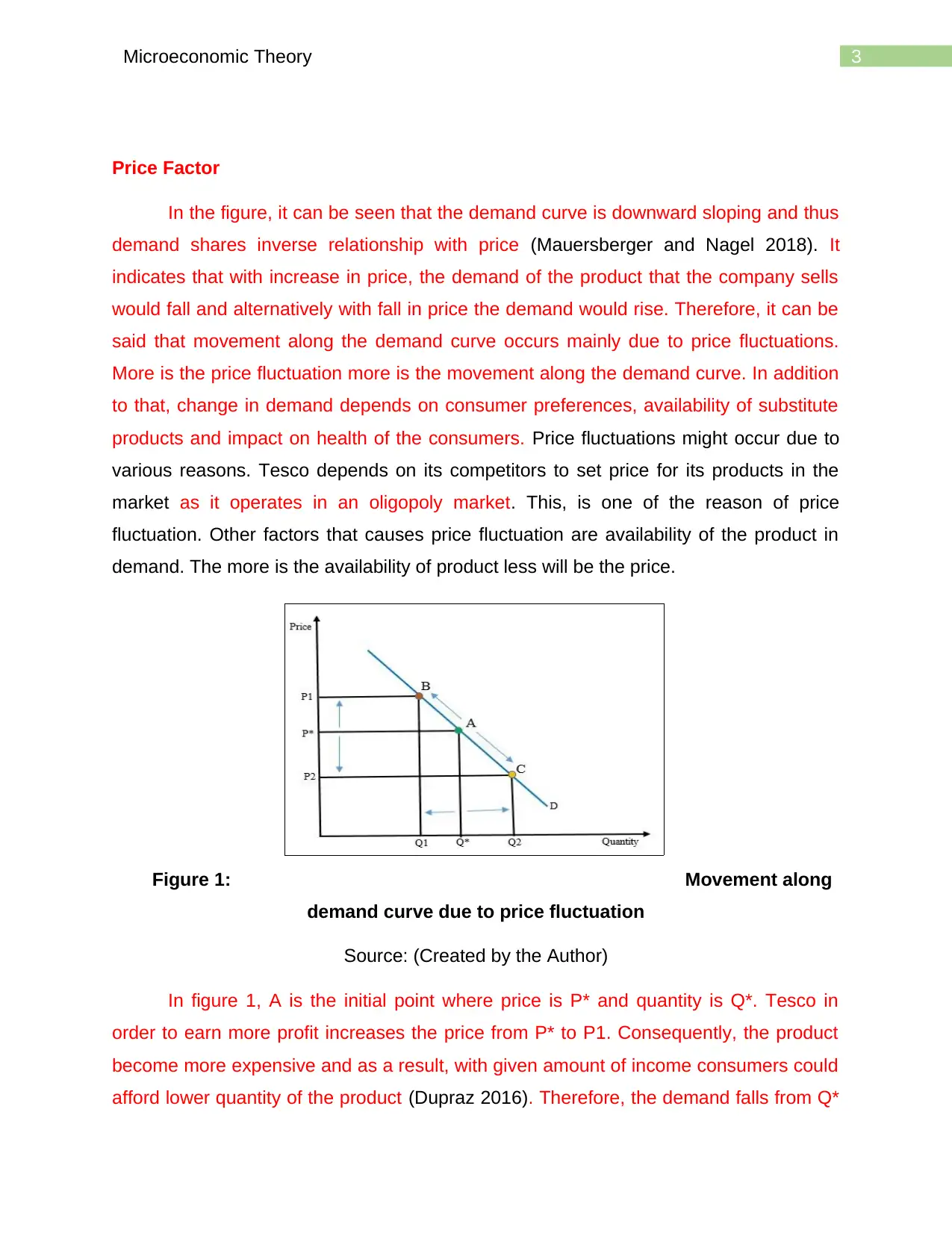
3Microeconomic Theory
Price Factor
In the figure, it can be seen that the demand curve is downward sloping and thus
demand shares inverse relationship with price (Mauersberger and Nagel 2018). It
indicates that with increase in price, the demand of the product that the company sells
would fall and alternatively with fall in price the demand would rise. Therefore, it can be
said that movement along the demand curve occurs mainly due to price fluctuations.
More is the price fluctuation more is the movement along the demand curve. In addition
to that, change in demand depends on consumer preferences, availability of substitute
products and impact on health of the consumers. Price fluctuations might occur due to
various reasons. Tesco depends on its competitors to set price for its products in the
market as it operates in an oligopoly market. This, is one of the reason of price
fluctuation. Other factors that causes price fluctuation are availability of the product in
demand. The more is the availability of product less will be the price.
Figure 1: Movement along
demand curve due to price fluctuation
Source: (Created by the Author)
In figure 1, A is the initial point where price is P* and quantity is Q*. Tesco in
order to earn more profit increases the price from P* to P1. Consequently, the product
become more expensive and as a result, with given amount of income consumers could
afford lower quantity of the product (Dupraz 2016). Therefore, the demand falls from Q*
Price Factor
In the figure, it can be seen that the demand curve is downward sloping and thus
demand shares inverse relationship with price (Mauersberger and Nagel 2018). It
indicates that with increase in price, the demand of the product that the company sells
would fall and alternatively with fall in price the demand would rise. Therefore, it can be
said that movement along the demand curve occurs mainly due to price fluctuations.
More is the price fluctuation more is the movement along the demand curve. In addition
to that, change in demand depends on consumer preferences, availability of substitute
products and impact on health of the consumers. Price fluctuations might occur due to
various reasons. Tesco depends on its competitors to set price for its products in the
market as it operates in an oligopoly market. This, is one of the reason of price
fluctuation. Other factors that causes price fluctuation are availability of the product in
demand. The more is the availability of product less will be the price.
Figure 1: Movement along
demand curve due to price fluctuation
Source: (Created by the Author)
In figure 1, A is the initial point where price is P* and quantity is Q*. Tesco in
order to earn more profit increases the price from P* to P1. Consequently, the product
become more expensive and as a result, with given amount of income consumers could
afford lower quantity of the product (Dupraz 2016). Therefore, the demand falls from Q*
Paraphrase This Document
Need a fresh take? Get an instant paraphrase of this document with our AI Paraphraser
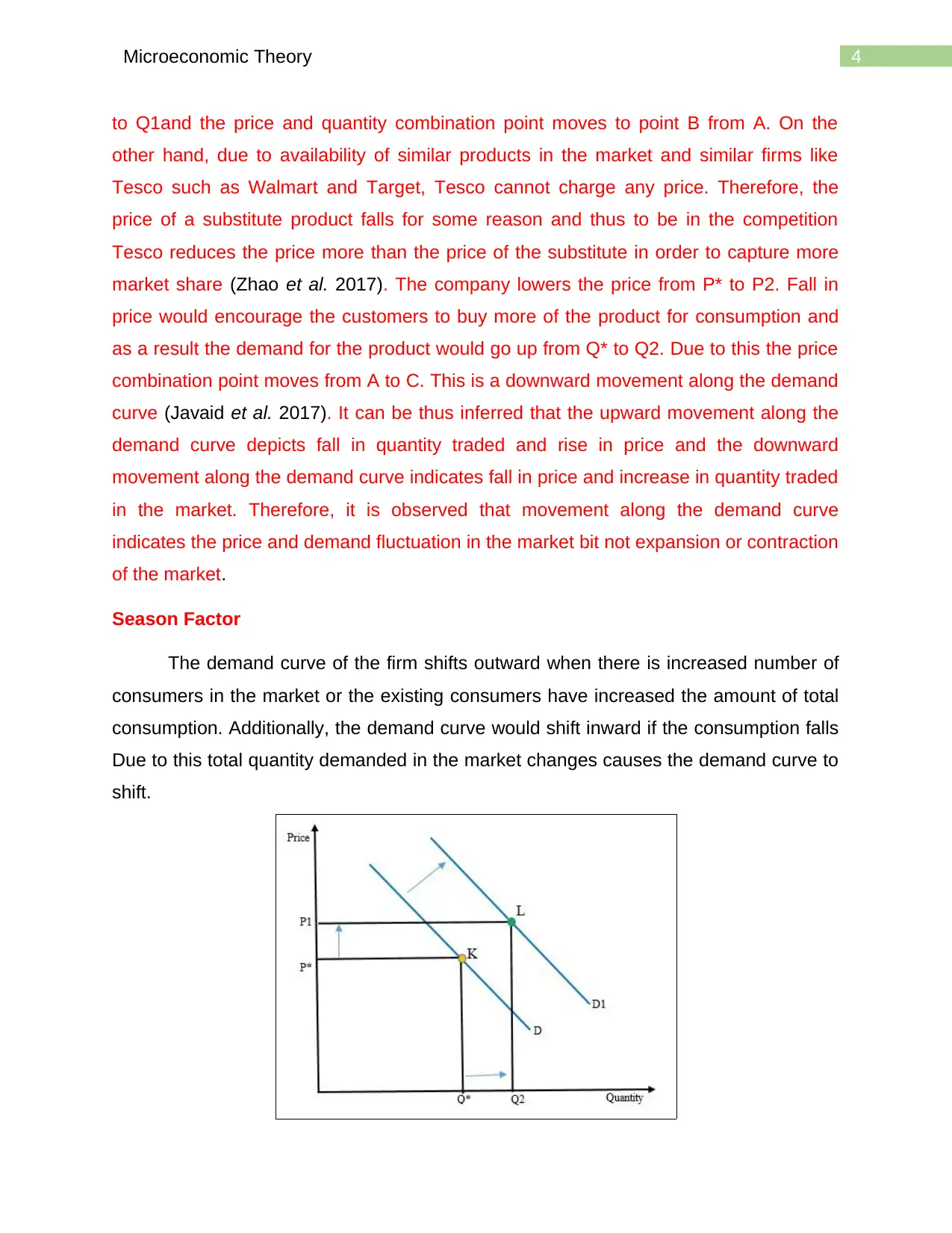
4Microeconomic Theory
to Q1and the price and quantity combination point moves to point B from A. On the
other hand, due to availability of similar products in the market and similar firms like
Tesco such as Walmart and Target, Tesco cannot charge any price. Therefore, the
price of a substitute product falls for some reason and thus to be in the competition
Tesco reduces the price more than the price of the substitute in order to capture more
market share (Zhao et al. 2017). The company lowers the price from P* to P2. Fall in
price would encourage the customers to buy more of the product for consumption and
as a result the demand for the product would go up from Q* to Q2. Due to this the price
combination point moves from A to C. This is a downward movement along the demand
curve (Javaid et al. 2017). It can be thus inferred that the upward movement along the
demand curve depicts fall in quantity traded and rise in price and the downward
movement along the demand curve indicates fall in price and increase in quantity traded
in the market. Therefore, it is observed that movement along the demand curve
indicates the price and demand fluctuation in the market bit not expansion or contraction
of the market.
Season Factor
The demand curve of the firm shifts outward when there is increased number of
consumers in the market or the existing consumers have increased the amount of total
consumption. Additionally, the demand curve would shift inward if the consumption falls
Due to this total quantity demanded in the market changes causes the demand curve to
shift.
to Q1and the price and quantity combination point moves to point B from A. On the
other hand, due to availability of similar products in the market and similar firms like
Tesco such as Walmart and Target, Tesco cannot charge any price. Therefore, the
price of a substitute product falls for some reason and thus to be in the competition
Tesco reduces the price more than the price of the substitute in order to capture more
market share (Zhao et al. 2017). The company lowers the price from P* to P2. Fall in
price would encourage the customers to buy more of the product for consumption and
as a result the demand for the product would go up from Q* to Q2. Due to this the price
combination point moves from A to C. This is a downward movement along the demand
curve (Javaid et al. 2017). It can be thus inferred that the upward movement along the
demand curve depicts fall in quantity traded and rise in price and the downward
movement along the demand curve indicates fall in price and increase in quantity traded
in the market. Therefore, it is observed that movement along the demand curve
indicates the price and demand fluctuation in the market bit not expansion or contraction
of the market.
Season Factor
The demand curve of the firm shifts outward when there is increased number of
consumers in the market or the existing consumers have increased the amount of total
consumption. Additionally, the demand curve would shift inward if the consumption falls
Due to this total quantity demanded in the market changes causes the demand curve to
shift.
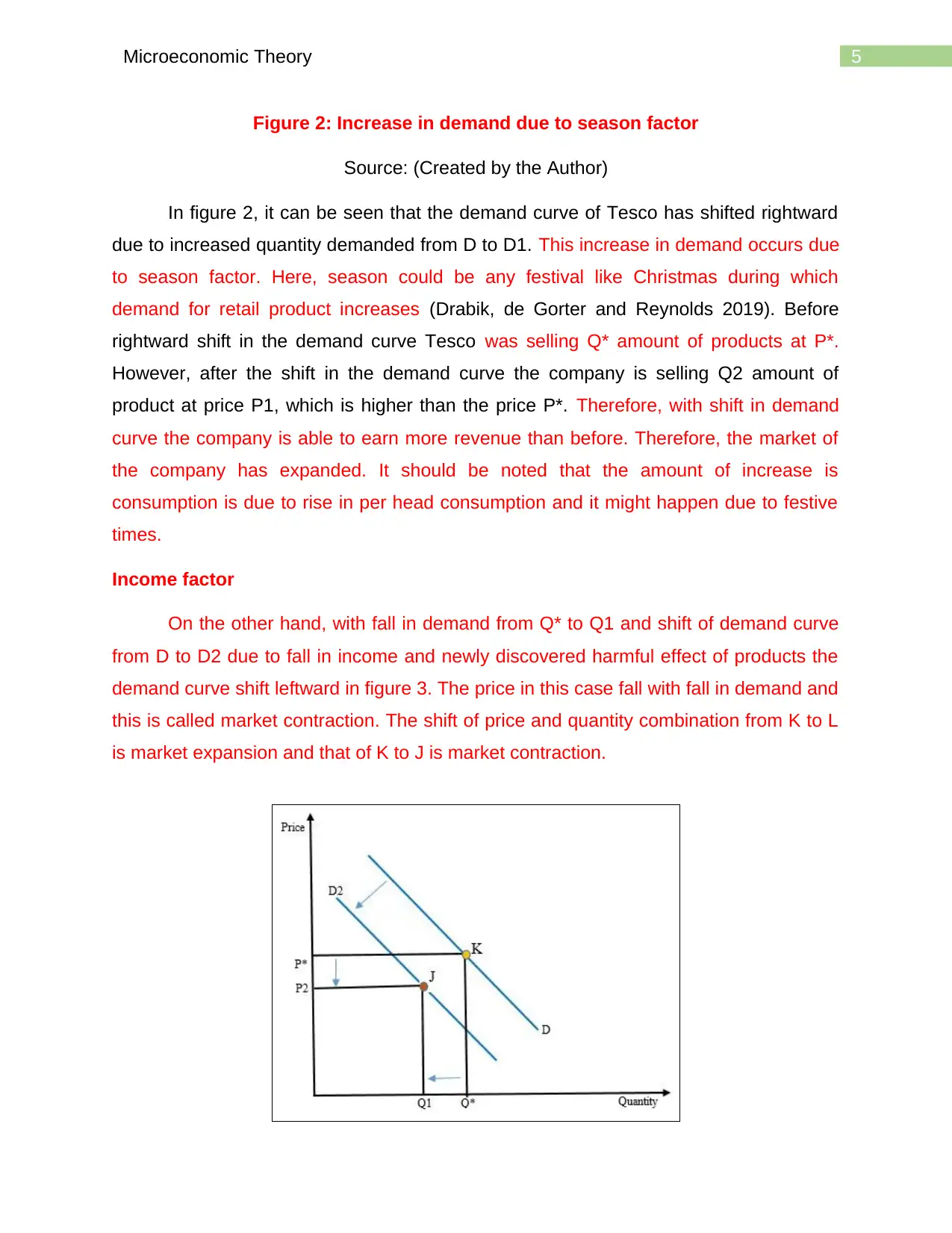
5Microeconomic Theory
Figure 2: Increase in demand due to season factor
Source: (Created by the Author)
In figure 2, it can be seen that the demand curve of Tesco has shifted rightward
due to increased quantity demanded from D to D1. This increase in demand occurs due
to season factor. Here, season could be any festival like Christmas during which
demand for retail product increases (Drabik, de Gorter and Reynolds 2019). Before
rightward shift in the demand curve Tesco was selling Q* amount of products at P*.
However, after the shift in the demand curve the company is selling Q2 amount of
product at price P1, which is higher than the price P*. Therefore, with shift in demand
curve the company is able to earn more revenue than before. Therefore, the market of
the company has expanded. It should be noted that the amount of increase is
consumption is due to rise in per head consumption and it might happen due to festive
times.
Income factor
On the other hand, with fall in demand from Q* to Q1 and shift of demand curve
from D to D2 due to fall in income and newly discovered harmful effect of products the
demand curve shift leftward in figure 3. The price in this case fall with fall in demand and
this is called market contraction. The shift of price and quantity combination from K to L
is market expansion and that of K to J is market contraction.
Figure 2: Increase in demand due to season factor
Source: (Created by the Author)
In figure 2, it can be seen that the demand curve of Tesco has shifted rightward
due to increased quantity demanded from D to D1. This increase in demand occurs due
to season factor. Here, season could be any festival like Christmas during which
demand for retail product increases (Drabik, de Gorter and Reynolds 2019). Before
rightward shift in the demand curve Tesco was selling Q* amount of products at P*.
However, after the shift in the demand curve the company is selling Q2 amount of
product at price P1, which is higher than the price P*. Therefore, with shift in demand
curve the company is able to earn more revenue than before. Therefore, the market of
the company has expanded. It should be noted that the amount of increase is
consumption is due to rise in per head consumption and it might happen due to festive
times.
Income factor
On the other hand, with fall in demand from Q* to Q1 and shift of demand curve
from D to D2 due to fall in income and newly discovered harmful effect of products the
demand curve shift leftward in figure 3. The price in this case fall with fall in demand and
this is called market contraction. The shift of price and quantity combination from K to L
is market expansion and that of K to J is market contraction.
⊘ This is a preview!⊘
Do you want full access?
Subscribe today to unlock all pages.

Trusted by 1+ million students worldwide
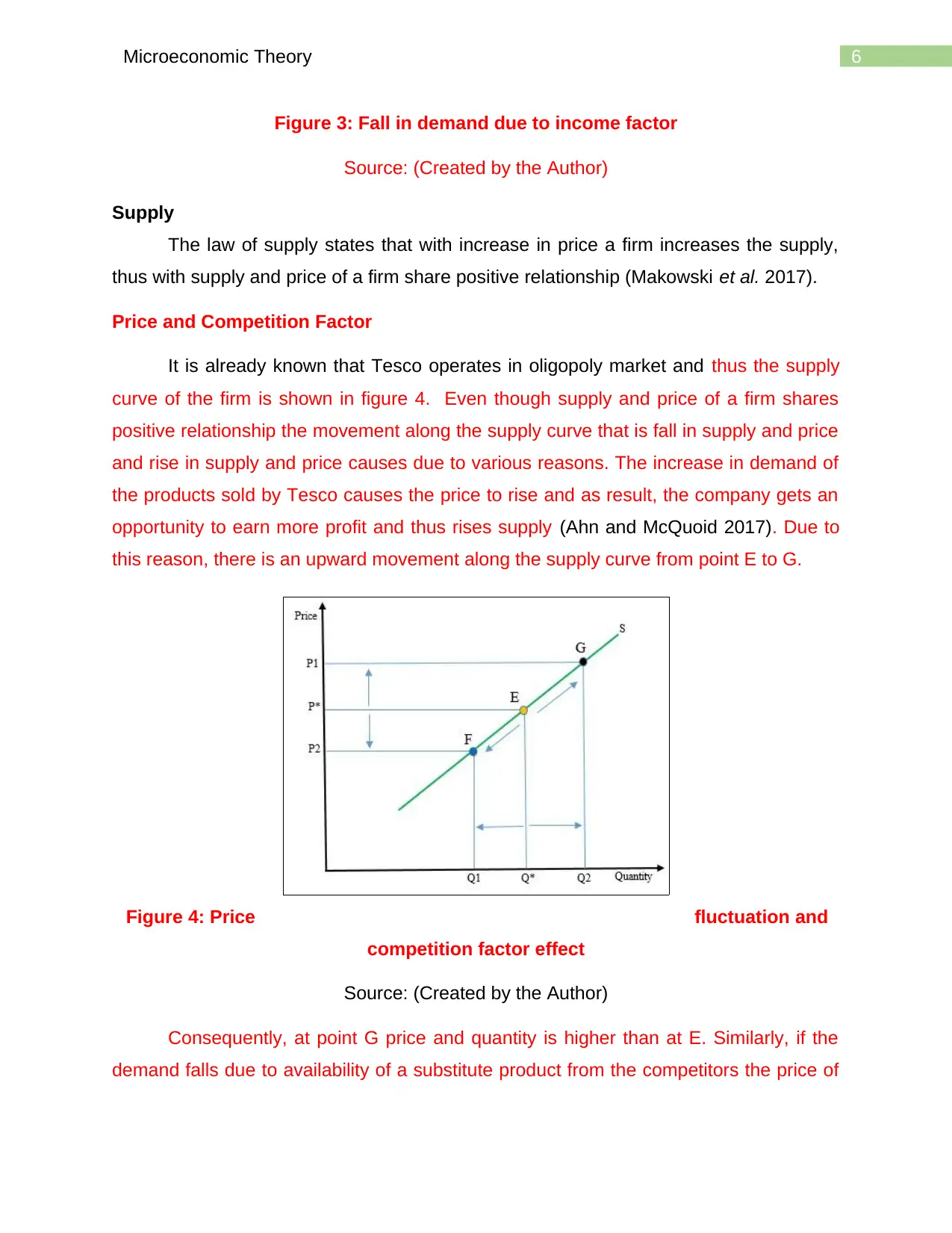
6Microeconomic Theory
Figure 3: Fall in demand due to income factor
Source: (Created by the Author)
Supply
The law of supply states that with increase in price a firm increases the supply,
thus with supply and price of a firm share positive relationship (Makowski et al. 2017).
Price and Competition Factor
It is already known that Tesco operates in oligopoly market and thus the supply
curve of the firm is shown in figure 4. Even though supply and price of a firm shares
positive relationship the movement along the supply curve that is fall in supply and price
and rise in supply and price causes due to various reasons. The increase in demand of
the products sold by Tesco causes the price to rise and as result, the company gets an
opportunity to earn more profit and thus rises supply (Ahn and McQuoid 2017). Due to
this reason, there is an upward movement along the supply curve from point E to G.
Figure 4: Price fluctuation and
competition factor effect
Source: (Created by the Author)
Consequently, at point G price and quantity is higher than at E. Similarly, if the
demand falls due to availability of a substitute product from the competitors the price of
Figure 3: Fall in demand due to income factor
Source: (Created by the Author)
Supply
The law of supply states that with increase in price a firm increases the supply,
thus with supply and price of a firm share positive relationship (Makowski et al. 2017).
Price and Competition Factor
It is already known that Tesco operates in oligopoly market and thus the supply
curve of the firm is shown in figure 4. Even though supply and price of a firm shares
positive relationship the movement along the supply curve that is fall in supply and price
and rise in supply and price causes due to various reasons. The increase in demand of
the products sold by Tesco causes the price to rise and as result, the company gets an
opportunity to earn more profit and thus rises supply (Ahn and McQuoid 2017). Due to
this reason, there is an upward movement along the supply curve from point E to G.
Figure 4: Price fluctuation and
competition factor effect
Source: (Created by the Author)
Consequently, at point G price and quantity is higher than at E. Similarly, if the
demand falls due to availability of a substitute product from the competitors the price of
Paraphrase This Document
Need a fresh take? Get an instant paraphrase of this document with our AI Paraphraser
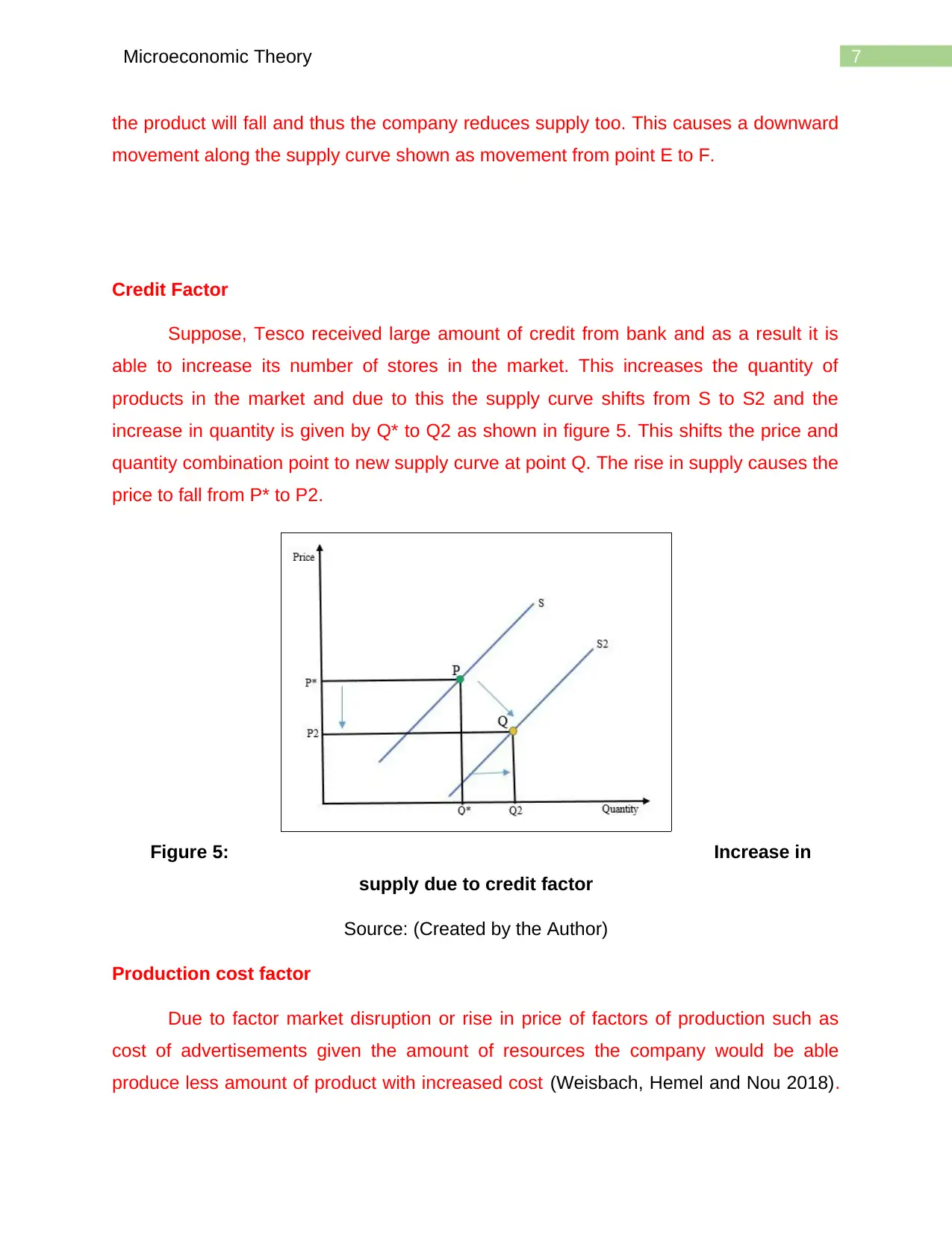
7Microeconomic Theory
the product will fall and thus the company reduces supply too. This causes a downward
movement along the supply curve shown as movement from point E to F.
Credit Factor
Suppose, Tesco received large amount of credit from bank and as a result it is
able to increase its number of stores in the market. This increases the quantity of
products in the market and due to this the supply curve shifts from S to S2 and the
increase in quantity is given by Q* to Q2 as shown in figure 5. This shifts the price and
quantity combination point to new supply curve at point Q. The rise in supply causes the
price to fall from P* to P2.
Figure 5: Increase in
supply due to credit factor
Source: (Created by the Author)
Production cost factor
Due to factor market disruption or rise in price of factors of production such as
cost of advertisements given the amount of resources the company would be able
produce less amount of product with increased cost (Weisbach, Hemel and Nou 2018).
the product will fall and thus the company reduces supply too. This causes a downward
movement along the supply curve shown as movement from point E to F.
Credit Factor
Suppose, Tesco received large amount of credit from bank and as a result it is
able to increase its number of stores in the market. This increases the quantity of
products in the market and due to this the supply curve shifts from S to S2 and the
increase in quantity is given by Q* to Q2 as shown in figure 5. This shifts the price and
quantity combination point to new supply curve at point Q. The rise in supply causes the
price to fall from P* to P2.
Figure 5: Increase in
supply due to credit factor
Source: (Created by the Author)
Production cost factor
Due to factor market disruption or rise in price of factors of production such as
cost of advertisements given the amount of resources the company would be able
produce less amount of product with increased cost (Weisbach, Hemel and Nou 2018).
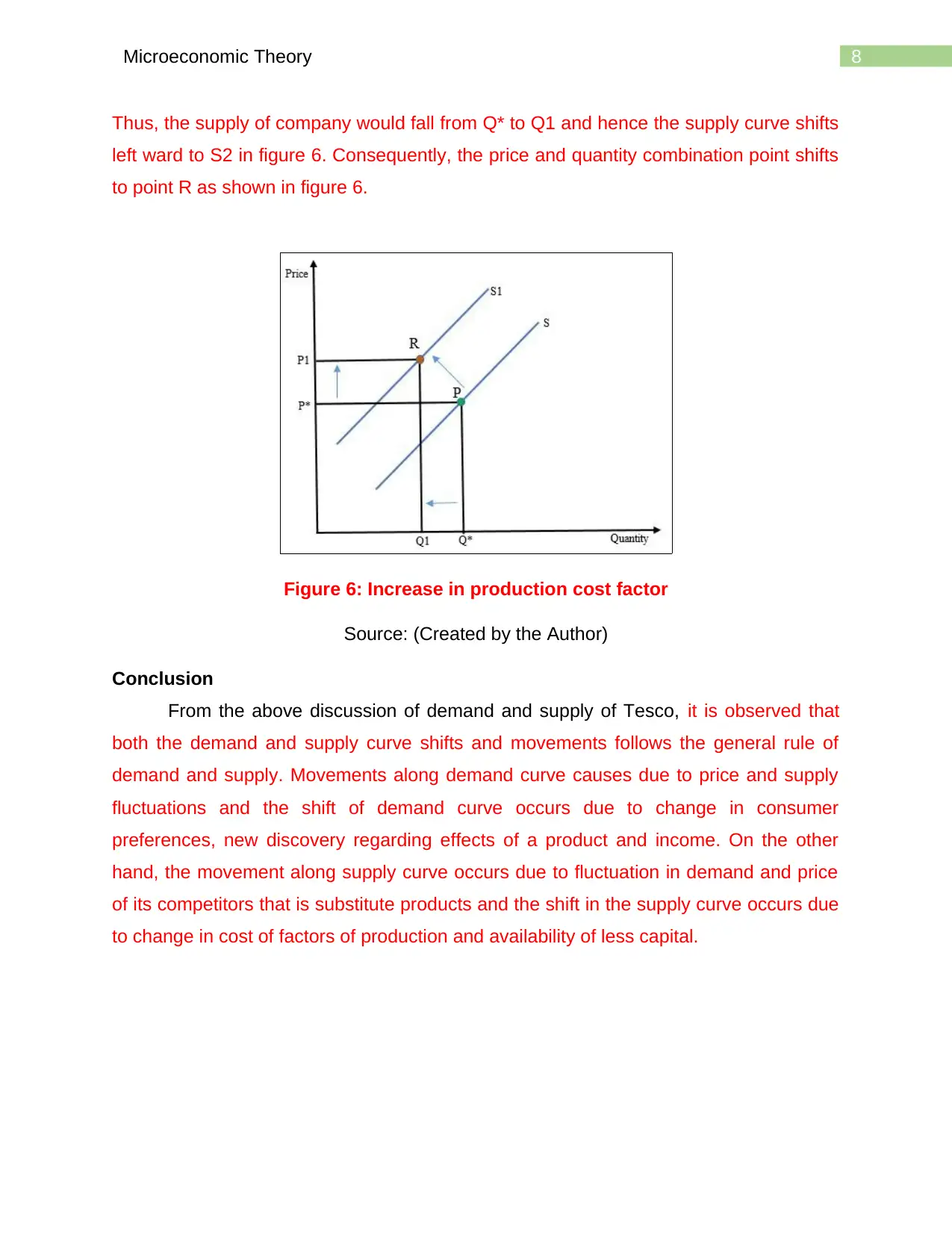
8Microeconomic Theory
Thus, the supply of company would fall from Q* to Q1 and hence the supply curve shifts
left ward to S2 in figure 6. Consequently, the price and quantity combination point shifts
to point R as shown in figure 6.
Figure 6: Increase in production cost factor
Source: (Created by the Author)
Conclusion
From the above discussion of demand and supply of Tesco, it is observed that
both the demand and supply curve shifts and movements follows the general rule of
demand and supply. Movements along demand curve causes due to price and supply
fluctuations and the shift of demand curve occurs due to change in consumer
preferences, new discovery regarding effects of a product and income. On the other
hand, the movement along supply curve occurs due to fluctuation in demand and price
of its competitors that is substitute products and the shift in the supply curve occurs due
to change in cost of factors of production and availability of less capital.
Thus, the supply of company would fall from Q* to Q1 and hence the supply curve shifts
left ward to S2 in figure 6. Consequently, the price and quantity combination point shifts
to point R as shown in figure 6.
Figure 6: Increase in production cost factor
Source: (Created by the Author)
Conclusion
From the above discussion of demand and supply of Tesco, it is observed that
both the demand and supply curve shifts and movements follows the general rule of
demand and supply. Movements along demand curve causes due to price and supply
fluctuations and the shift of demand curve occurs due to change in consumer
preferences, new discovery regarding effects of a product and income. On the other
hand, the movement along supply curve occurs due to fluctuation in demand and price
of its competitors that is substitute products and the shift in the supply curve occurs due
to change in cost of factors of production and availability of less capital.
⊘ This is a preview!⊘
Do you want full access?
Subscribe today to unlock all pages.

Trusted by 1+ million students worldwide
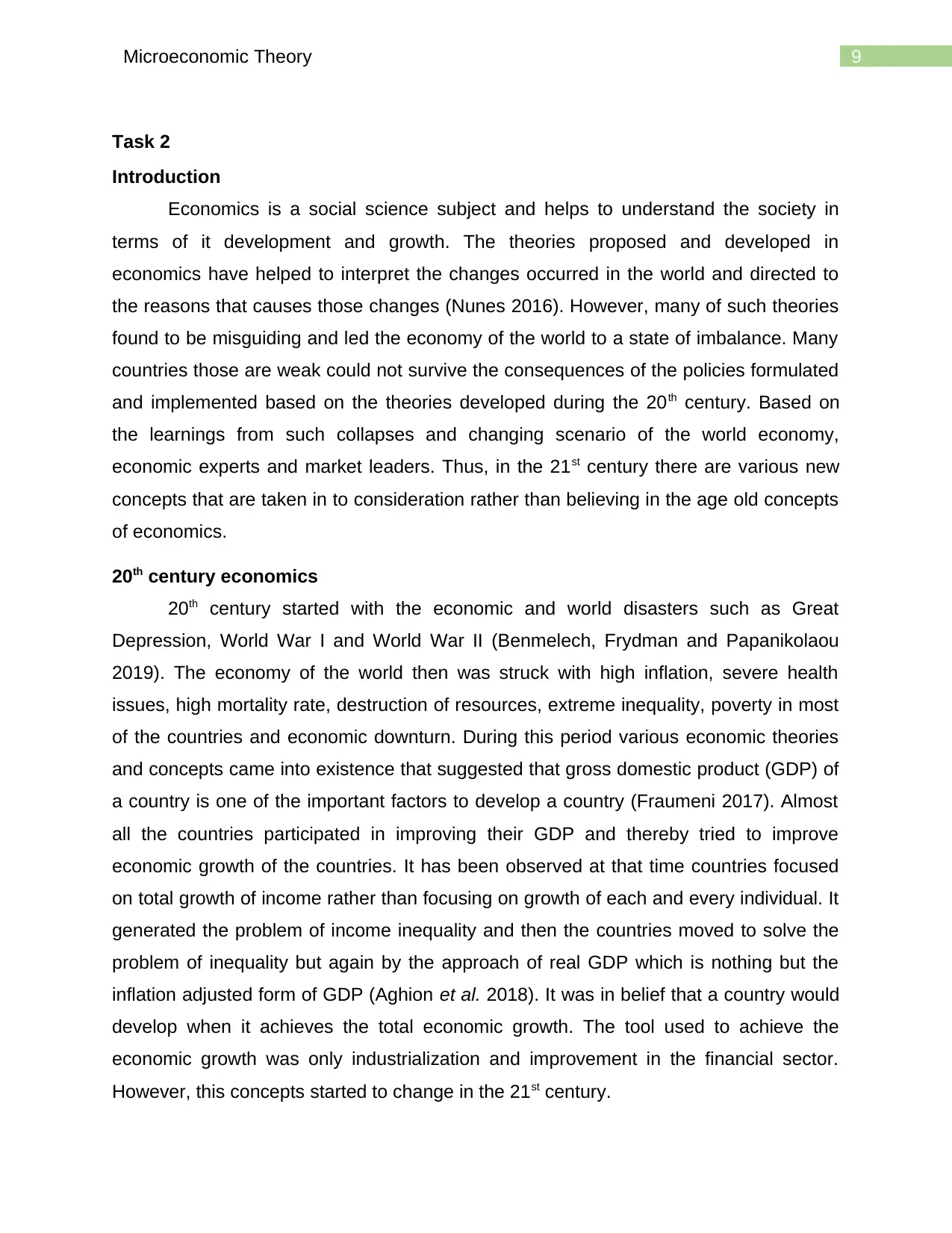
9Microeconomic Theory
Task 2
Introduction
Economics is a social science subject and helps to understand the society in
terms of it development and growth. The theories proposed and developed in
economics have helped to interpret the changes occurred in the world and directed to
the reasons that causes those changes (Nunes 2016). However, many of such theories
found to be misguiding and led the economy of the world to a state of imbalance. Many
countries those are weak could not survive the consequences of the policies formulated
and implemented based on the theories developed during the 20th century. Based on
the learnings from such collapses and changing scenario of the world economy,
economic experts and market leaders. Thus, in the 21st century there are various new
concepts that are taken in to consideration rather than believing in the age old concepts
of economics.
20th century economics
20th century started with the economic and world disasters such as Great
Depression, World War I and World War II (Benmelech, Frydman and Papanikolaou
2019). The economy of the world then was struck with high inflation, severe health
issues, high mortality rate, destruction of resources, extreme inequality, poverty in most
of the countries and economic downturn. During this period various economic theories
and concepts came into existence that suggested that gross domestic product (GDP) of
a country is one of the important factors to develop a country (Fraumeni 2017). Almost
all the countries participated in improving their GDP and thereby tried to improve
economic growth of the countries. It has been observed at that time countries focused
on total growth of income rather than focusing on growth of each and every individual. It
generated the problem of income inequality and then the countries moved to solve the
problem of inequality but again by the approach of real GDP which is nothing but the
inflation adjusted form of GDP (Aghion et al. 2018). It was in belief that a country would
develop when it achieves the total economic growth. The tool used to achieve the
economic growth was only industrialization and improvement in the financial sector.
However, this concepts started to change in the 21st century.
Task 2
Introduction
Economics is a social science subject and helps to understand the society in
terms of it development and growth. The theories proposed and developed in
economics have helped to interpret the changes occurred in the world and directed to
the reasons that causes those changes (Nunes 2016). However, many of such theories
found to be misguiding and led the economy of the world to a state of imbalance. Many
countries those are weak could not survive the consequences of the policies formulated
and implemented based on the theories developed during the 20th century. Based on
the learnings from such collapses and changing scenario of the world economy,
economic experts and market leaders. Thus, in the 21st century there are various new
concepts that are taken in to consideration rather than believing in the age old concepts
of economics.
20th century economics
20th century started with the economic and world disasters such as Great
Depression, World War I and World War II (Benmelech, Frydman and Papanikolaou
2019). The economy of the world then was struck with high inflation, severe health
issues, high mortality rate, destruction of resources, extreme inequality, poverty in most
of the countries and economic downturn. During this period various economic theories
and concepts came into existence that suggested that gross domestic product (GDP) of
a country is one of the important factors to develop a country (Fraumeni 2017). Almost
all the countries participated in improving their GDP and thereby tried to improve
economic growth of the countries. It has been observed at that time countries focused
on total growth of income rather than focusing on growth of each and every individual. It
generated the problem of income inequality and then the countries moved to solve the
problem of inequality but again by the approach of real GDP which is nothing but the
inflation adjusted form of GDP (Aghion et al. 2018). It was in belief that a country would
develop when it achieves the total economic growth. The tool used to achieve the
economic growth was only industrialization and improvement in the financial sector.
However, this concepts started to change in the 21st century.
Paraphrase This Document
Need a fresh take? Get an instant paraphrase of this document with our AI Paraphraser
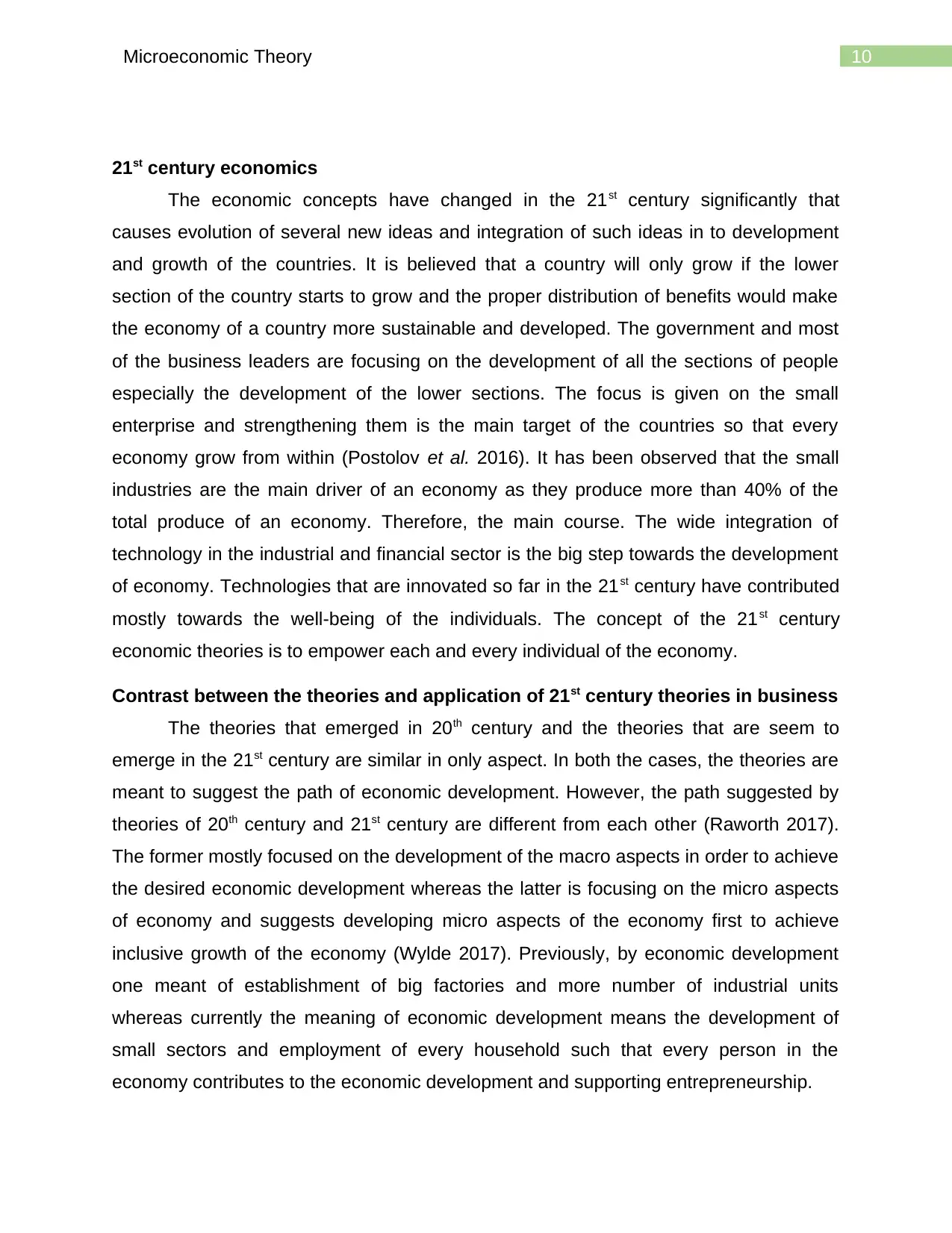
10Microeconomic Theory
21st century economics
The economic concepts have changed in the 21st century significantly that
causes evolution of several new ideas and integration of such ideas in to development
and growth of the countries. It is believed that a country will only grow if the lower
section of the country starts to grow and the proper distribution of benefits would make
the economy of a country more sustainable and developed. The government and most
of the business leaders are focusing on the development of all the sections of people
especially the development of the lower sections. The focus is given on the small
enterprise and strengthening them is the main target of the countries so that every
economy grow from within (Postolov et al. 2016). It has been observed that the small
industries are the main driver of an economy as they produce more than 40% of the
total produce of an economy. Therefore, the main course. The wide integration of
technology in the industrial and financial sector is the big step towards the development
of economy. Technologies that are innovated so far in the 21st century have contributed
mostly towards the well-being of the individuals. The concept of the 21st century
economic theories is to empower each and every individual of the economy.
Contrast between the theories and application of 21st century theories in business
The theories that emerged in 20th century and the theories that are seem to
emerge in the 21st century are similar in only aspect. In both the cases, the theories are
meant to suggest the path of economic development. However, the path suggested by
theories of 20th century and 21st century are different from each other (Raworth 2017).
The former mostly focused on the development of the macro aspects in order to achieve
the desired economic development whereas the latter is focusing on the micro aspects
of economy and suggests developing micro aspects of the economy first to achieve
inclusive growth of the economy (Wylde 2017). Previously, by economic development
one meant of establishment of big factories and more number of industrial units
whereas currently the meaning of economic development means the development of
small sectors and employment of every household such that every person in the
economy contributes to the economic development and supporting entrepreneurship.
21st century economics
The economic concepts have changed in the 21st century significantly that
causes evolution of several new ideas and integration of such ideas in to development
and growth of the countries. It is believed that a country will only grow if the lower
section of the country starts to grow and the proper distribution of benefits would make
the economy of a country more sustainable and developed. The government and most
of the business leaders are focusing on the development of all the sections of people
especially the development of the lower sections. The focus is given on the small
enterprise and strengthening them is the main target of the countries so that every
economy grow from within (Postolov et al. 2016). It has been observed that the small
industries are the main driver of an economy as they produce more than 40% of the
total produce of an economy. Therefore, the main course. The wide integration of
technology in the industrial and financial sector is the big step towards the development
of economy. Technologies that are innovated so far in the 21st century have contributed
mostly towards the well-being of the individuals. The concept of the 21st century
economic theories is to empower each and every individual of the economy.
Contrast between the theories and application of 21st century theories in business
The theories that emerged in 20th century and the theories that are seem to
emerge in the 21st century are similar in only aspect. In both the cases, the theories are
meant to suggest the path of economic development. However, the path suggested by
theories of 20th century and 21st century are different from each other (Raworth 2017).
The former mostly focused on the development of the macro aspects in order to achieve
the desired economic development whereas the latter is focusing on the micro aspects
of economy and suggests developing micro aspects of the economy first to achieve
inclusive growth of the economy (Wylde 2017). Previously, by economic development
one meant of establishment of big factories and more number of industrial units
whereas currently the meaning of economic development means the development of
small sectors and employment of every household such that every person in the
economy contributes to the economic development and supporting entrepreneurship.
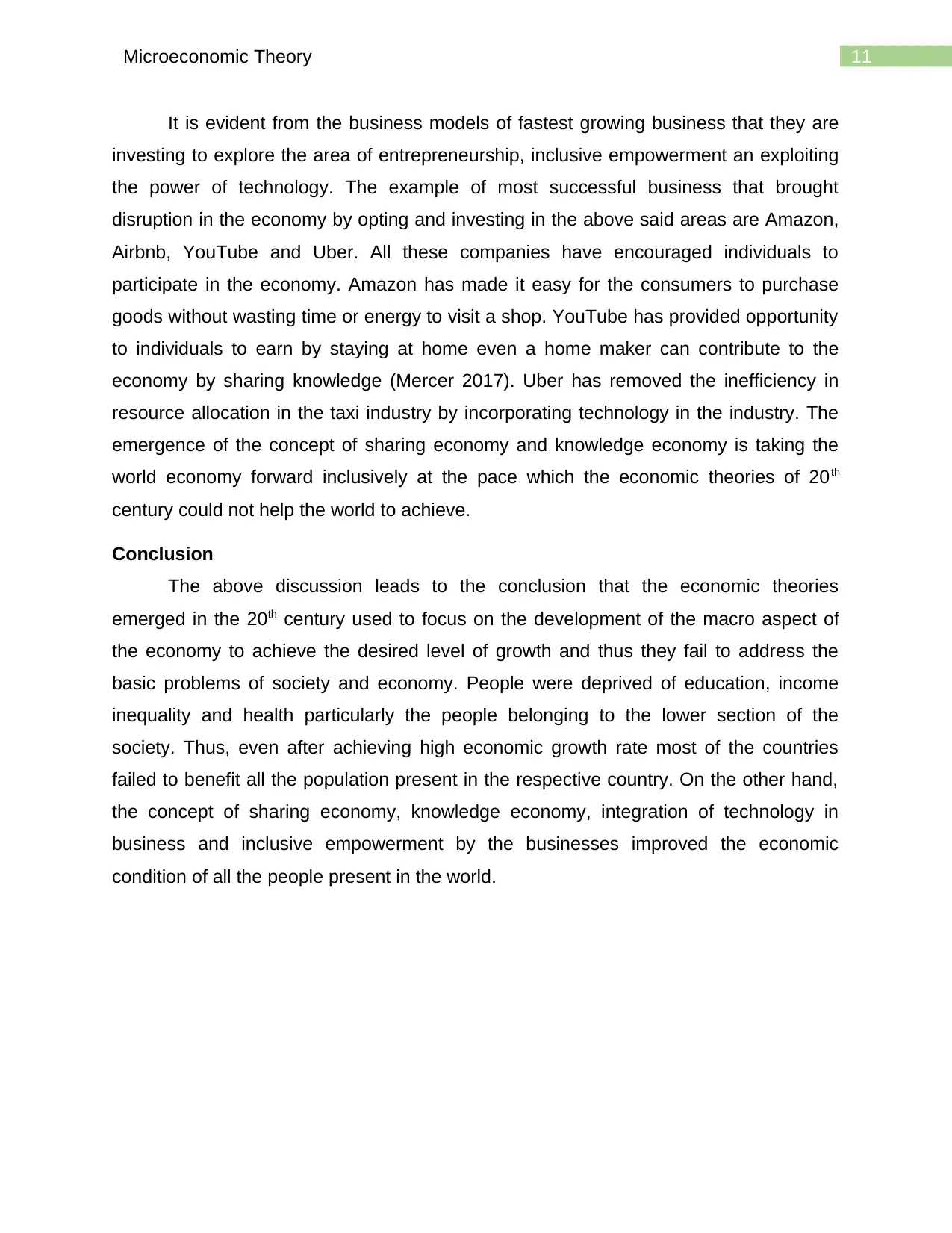
11Microeconomic Theory
It is evident from the business models of fastest growing business that they are
investing to explore the area of entrepreneurship, inclusive empowerment an exploiting
the power of technology. The example of most successful business that brought
disruption in the economy by opting and investing in the above said areas are Amazon,
Airbnb, YouTube and Uber. All these companies have encouraged individuals to
participate in the economy. Amazon has made it easy for the consumers to purchase
goods without wasting time or energy to visit a shop. YouTube has provided opportunity
to individuals to earn by staying at home even a home maker can contribute to the
economy by sharing knowledge (Mercer 2017). Uber has removed the inefficiency in
resource allocation in the taxi industry by incorporating technology in the industry. The
emergence of the concept of sharing economy and knowledge economy is taking the
world economy forward inclusively at the pace which the economic theories of 20th
century could not help the world to achieve.
Conclusion
The above discussion leads to the conclusion that the economic theories
emerged in the 20th century used to focus on the development of the macro aspect of
the economy to achieve the desired level of growth and thus they fail to address the
basic problems of society and economy. People were deprived of education, income
inequality and health particularly the people belonging to the lower section of the
society. Thus, even after achieving high economic growth rate most of the countries
failed to benefit all the population present in the respective country. On the other hand,
the concept of sharing economy, knowledge economy, integration of technology in
business and inclusive empowerment by the businesses improved the economic
condition of all the people present in the world.
It is evident from the business models of fastest growing business that they are
investing to explore the area of entrepreneurship, inclusive empowerment an exploiting
the power of technology. The example of most successful business that brought
disruption in the economy by opting and investing in the above said areas are Amazon,
Airbnb, YouTube and Uber. All these companies have encouraged individuals to
participate in the economy. Amazon has made it easy for the consumers to purchase
goods without wasting time or energy to visit a shop. YouTube has provided opportunity
to individuals to earn by staying at home even a home maker can contribute to the
economy by sharing knowledge (Mercer 2017). Uber has removed the inefficiency in
resource allocation in the taxi industry by incorporating technology in the industry. The
emergence of the concept of sharing economy and knowledge economy is taking the
world economy forward inclusively at the pace which the economic theories of 20th
century could not help the world to achieve.
Conclusion
The above discussion leads to the conclusion that the economic theories
emerged in the 20th century used to focus on the development of the macro aspect of
the economy to achieve the desired level of growth and thus they fail to address the
basic problems of society and economy. People were deprived of education, income
inequality and health particularly the people belonging to the lower section of the
society. Thus, even after achieving high economic growth rate most of the countries
failed to benefit all the population present in the respective country. On the other hand,
the concept of sharing economy, knowledge economy, integration of technology in
business and inclusive empowerment by the businesses improved the economic
condition of all the people present in the world.
⊘ This is a preview!⊘
Do you want full access?
Subscribe today to unlock all pages.

Trusted by 1+ million students worldwide
1 out of 14
Related Documents
Your All-in-One AI-Powered Toolkit for Academic Success.
+13062052269
info@desklib.com
Available 24*7 on WhatsApp / Email
![[object Object]](/_next/static/media/star-bottom.7253800d.svg)
Unlock your academic potential
Copyright © 2020–2025 A2Z Services. All Rights Reserved. Developed and managed by ZUCOL.




